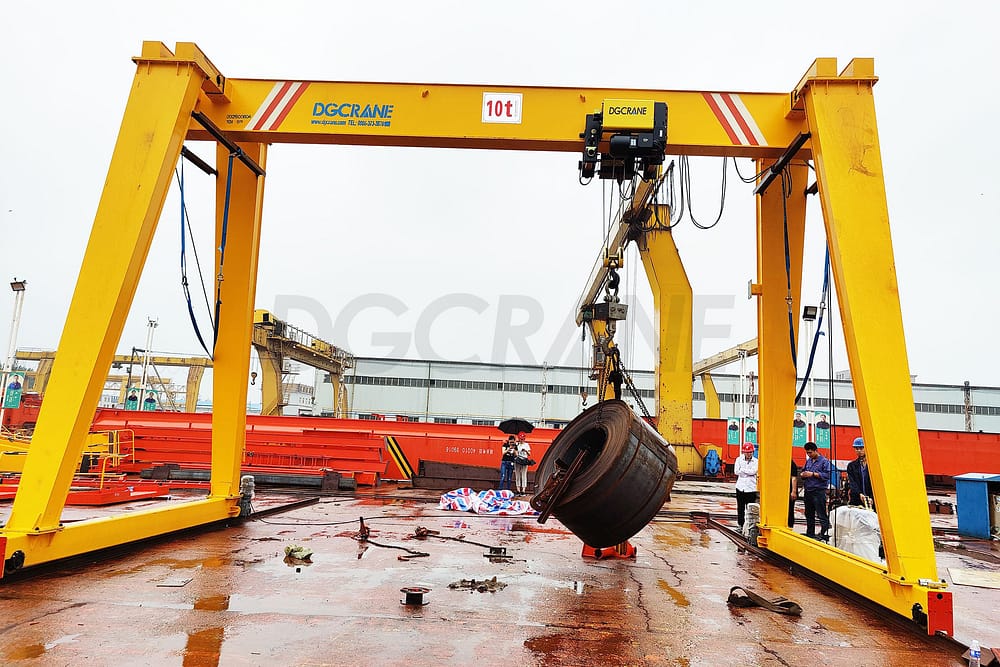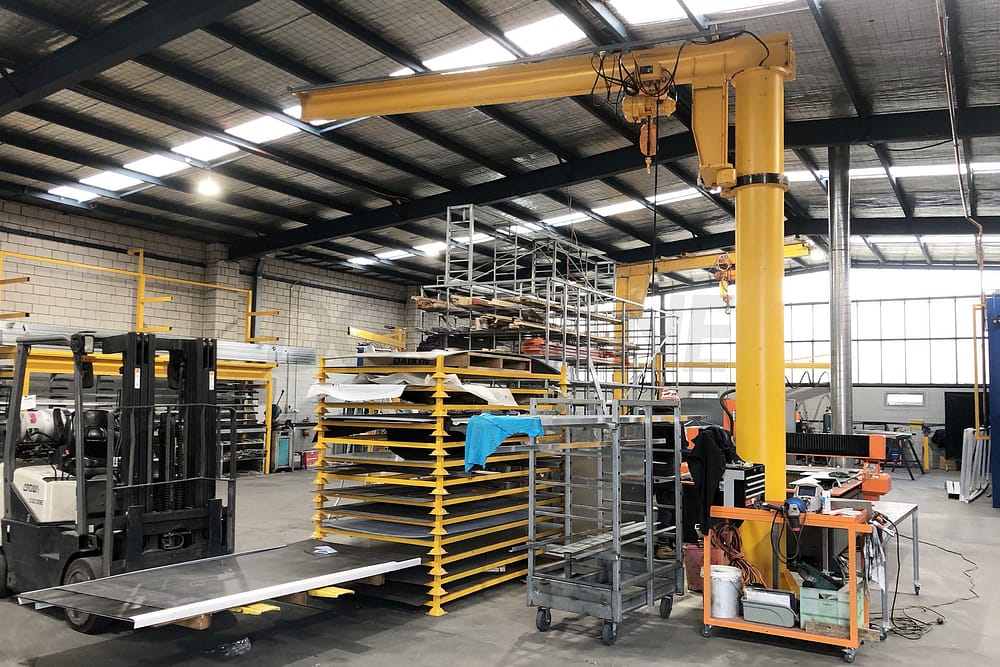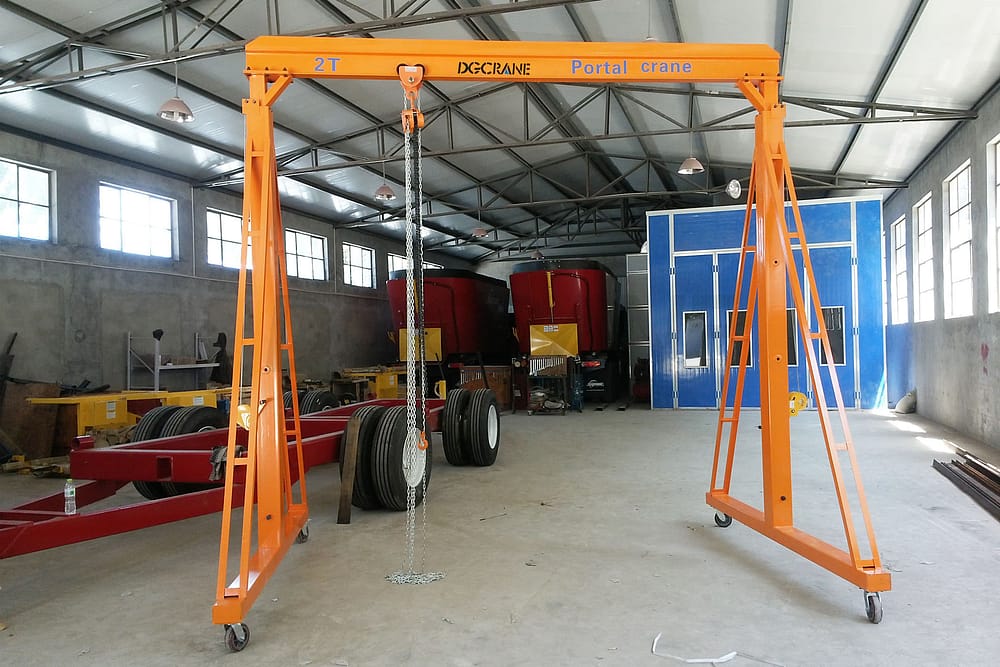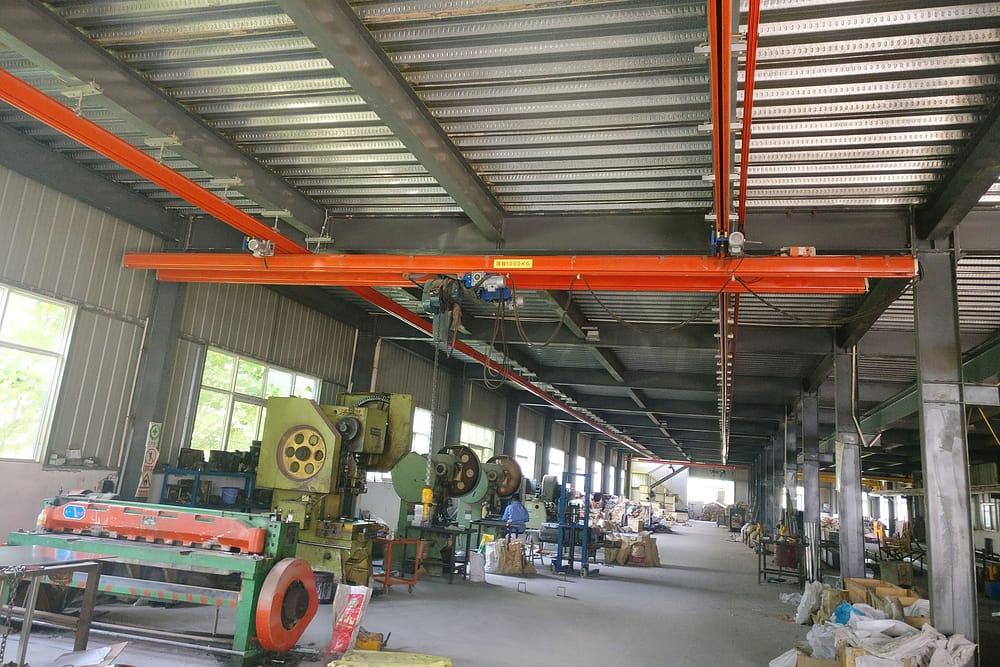Types of Crane Used in Factories
Cranes are lifting equipment widely used in various industries for transporting and moving heavy objects. Several types of cranes are available, each with unique features and capabilities. In this article, we will explore the six main types of cranes: overhead cranes, gantry cranes, jib cranes, portable gantry cranes, workstation overhead cranes, and electric hoists, and their respective advantages and suitability for different types of factory conditions.
Overhead Cranes -The best types of cranes for most plants
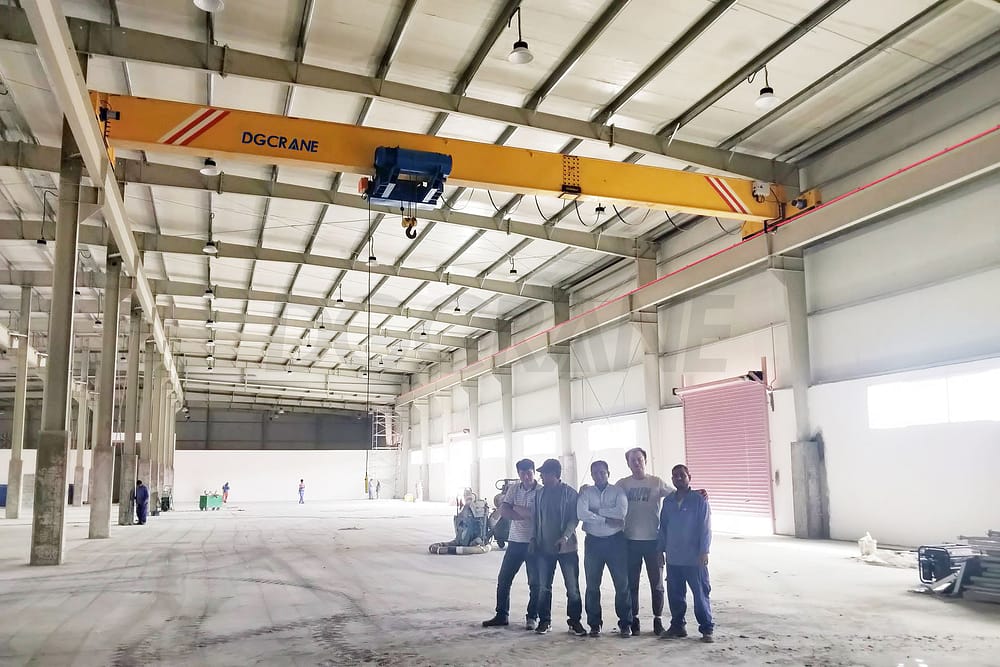
An overhead crane is a type of crane that is commonly used in industrial settings for the transportation and movement of heavy objects. These cranes are suspended from the ceiling or roof of the building, allowing them to move heavy loads throughout the facility.
Advantages of Overhead Cranes
One of the primary advantages of overhead cranes is their ability to lift heavy loads. These cranes can lift objects weighing several tons, making them ideal for industries such as construction, manufacturing, and warehousing. Additionally, overhead cranes can move in multiple directions, which increases their flexibility and versatility.
Another advantage of overhead cranes is their high speed and precision. These cranes can move quickly and accurately, reducing the time and effort required to move heavy objects from one location to another. Overhead cranes are also ideal for facilities with limited floor space, as they do not require a lot of floor space.
Suitable Conditions for Overhead Cranes
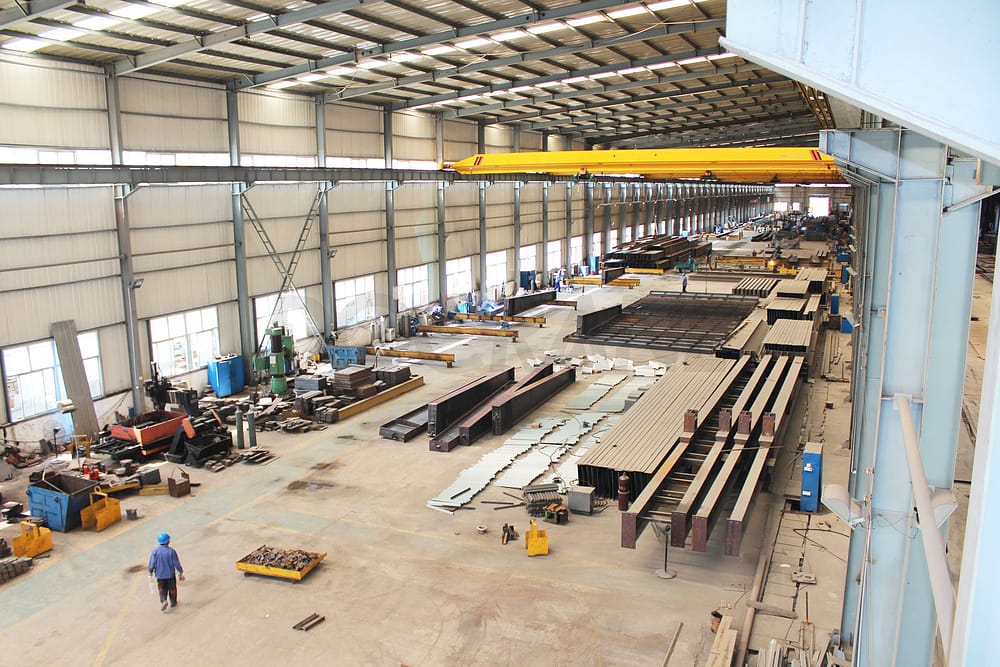
Overhead cranes are suitable for a wide range of industrial settings, including manufacturing plants, warehouses, and construction sites. They are particularly useful in facilities where heavy loads need to be lifted and moved over long distances. Additionally, overhead cranes are well-suited for facilities with limited floor space, as they can be suspended from the ceiling or roof.
Overhead cranes are also ideal for facilities where precision and speed are required, such as in manufacturing plants where heavy equipment needs to be moved quickly and accurately. These cranes are also suitable for facilities where there is a need to move heavy loads in multiple directions, as overhead cranes can move along a range of axes.
Unsuitable Conditions for Overhead Cranes

While overhead cranes are suitable for a wide range of industrial settings, there are some conditions in which they may not be ideal. For example, facilities with low ceilings may not have enough space to accommodate overhead cranes. Similarly, plant facilities are not suitable when they are not able to withstand the weight of the overhead crane and lift heavy objects.
Additionally, overhead cranes require special protective measures when used in harsh or corrosive plant conditions. Because in such conditions, crane components may be damaged or corroded over time, reducing the crane’s effectiveness and potentially causing safety problems.
Gantry Cranes -The ideal types of cranes for outdoor plant conditions
Gantry cranes are a type of crane that is used for lifting and moving heavy objects in a variety of industrial settings. These cranes are typically supported by two or more legs that run along rails or tracks, allowing them to move horizontally as well as vertically.
Advantages of Gantry Cranes
One of the primary advantages of gantry cranes is their mobility. These cranes can be easily moved and positioned around a facility, allowing them to be used in a variety of locations. Additionally, gantry cranes can lift heavy loads with ease, making them ideal for industrial settings such as construction sites, shipping yards, and manufacturing plants.
Another advantage of gantry cranes is their versatility. These cranes can be customized to meet the specific needs of a facility, with different models and configurations available to suit a range of applications. Gantry cranes can also be equipped with a range of features such as hoists, trolleys, and remote controls, which increases their flexibility and adaptability.
Suitable Conditions for Gantry Cranes
Gantry cranes are suitable for a wide range of industrial settings, including manufacturing plants, shipping yards, and construction sites. They are particularly useful in facilities where heavy loads need to be lifted and moved over long distances. Additionally, gantry cranes are well-suited for facilities with limited floor space, as they can be positioned above machinery or other obstacles.
Gantry cranes are also ideal for facilities where mobility and versatility are required. These cranes can be easily moved and positioned, allowing them to be used in a variety of locations. Additionally, gantry cranes can be customized to meet the specific needs of a facility, making them a popular choice in industries such as construction and manufacturing.
Unsuitable Conditions for Gantry Cranes
While gantry cranes are suitable for a wide range of industrial settings, there are some conditions in which they may not be ideal. For example, facilities with low ceilings may not have enough space to accommodate gantry cranes. Similarly, plants with uneven surfaces or limited floor space may not be able to support the movement and lifting of gantry cranes.
Additionally, the gantry crane in some often windy and rainy conditions of use, the lifting mechanism to do rain cover and other protective facilities, or the use of special outrigger design and other measures to ensure the safety of crane operations.
Jib Cranes – The best types of cranes to assist with large lifting equipment
Jib cranes are a type of crane that is typically used in smaller industrial settings for lifting and moving loads. These cranes consist of a horizontal beam or jib that is supported by a vertical mast, allowing them to rotate and extend to reach objects in a specific area.
Advantages of Jib Cranes
One of the primary advantages of jib cranes is their compact size. These cranes are typically smaller than other types of cranes such as overhead or gantry cranes, making them ideal for facilities with limited space. Additionally, jib cranes are relatively simple in design and easy to operate, making them a cost-effective option for smaller operations.
Another advantage of jib cranes is their versatility. These cranes can be installed in a variety of locations, such as on the wall or column, allowing them to be used in areas where floor space is limited. Additionally, jib cranes can be customized with different types of hoists and trolleys, allowing them to handle a wide range of loads.
Suitable Conditions for Jib Cranes
Jib cranes are suitable for a variety of industrial settings, particularly those with limited space. They are commonly used in manufacturing plants, warehouses, and workshops for tasks such as lifting and moving materials and equipment.
Jib cranes are particularly well-suited for facilities where loads need to be moved quickly and efficiently over a short distance. Additionally, these cranes are ideal for facilities with high ceilings, as they can be mounted on the ceiling or a supporting column to maximize floor space.
Unsuitable Conditions for Jib Cranes
While jib cranes are suitable for many industrial settings, there are some conditions in which they may not be ideal. For example, jib cranes may not be suitable for facilities where loads need to be lifted and moved over a long distance, as they have a limited reach compared to other types of cranes.
Additionally, free-standing jib cranes may not be suitable for use in environments where the ground structure is soft, as the base of the crane must be firmly anchored to prevent tipping.
Portable Gantry Cranes – The most flexible types of cranes
Portable gantry cranes are cranes that can be easily moved and transported to different locations. These cranes consist of a horizontal beam supported by two vertical legs and wheels that generally use gimbals, making it possible to lift and move loads around the area in a flexible manner.
Advantages of Portable Gantry Cranes
One of the primary advantages of portable gantry cranes is their flexibility. These cranes can be easily moved and set up in different locations, making them ideal for facilities that require frequent lifting and moving of loads in various areas. Additionally, portable gantry cranes are relatively easy to assemble and disassemble, requiring minimal tools and equipment.
Another advantage of portable gantry cranes is their versatility. These cranes can be customized with different types of hoists and trolleys, allowing them to handle a wide range of loads. Additionally, portable gantry cranes are available in different sizes and weight capacities, making them suitable for a variety of applications.
Suitable Conditions for Portable Gantry Cranes
Portable gantry cranes are suitable for a variety of industrial settings, particularly those where loads need to be lifted and moved in different locations. They are commonly used in construction sites, shipyards, and workshops for tasks such as lifting and moving materials and equipment.
Portable gantry cranes are particularly well-suited for facilities where there is limited overhead clearance or where permanent overhead cranes are not practical. Additionally, these cranes are ideal for facilities that require frequent changes to the lifting and moving areas, as they can be easily moved to different locations as needed.
Unsuitable Conditions for Portable Gantry Cranes
While portable gantry cranes are suitable for many industrial settings, there are some conditions in which they may not be ideal. For example, portable gantry cranes may not be suitable for facilities where loads need to be lifted and moved over a long distance, as they have a limited reach compared to other types of cranes.
Additionally, portable gantry cranes may not be suitable for facilities where loads are extremely heavy or require a high elevation, as the weight capacity and height of the crane may be limited. Portable gantry cranes may also not be ideal for facilities where there is limited floor space, as the legs of the crane can take up a significant amount of space.
Workstation Overhead Cranes – The best types of cranes for small and medium-sized plants
Workstation overhead cranes are a type of overhead crane that is designed for use in small areas, such as factories, workshops, and warehouses. These cranes are typically used to lift and move materials and equipment within a specific workstation or area.
Advantages of Workstation Overhead Cranes
One of the primary advantages of workstation overhead cranes is their ability to maximize floor space. These cranes are designed to operate within a specific workstation or area, allowing them to move loads without taking up valuable floor space. This makes them ideal for facilities with limited space, where the use of a larger overhead crane would not be practical.
Another advantage of workstation overhead cranes is their ease of use. These cranes are typically operated by a single worker using a remote control, allowing for precise and efficient movement of loads. Additionally, workstation overhead cranes are available in a range of sizes and weight capacities, making them suitable for a variety of applications.
Suitable Conditions for Workstation Overhead Cranes
Workstation overhead cranes are suitable for a range of industrial settings, particularly those where space is at a premium. They are commonly used in manufacturing facilities, assembly lines, and workshops for tasks such as moving materials and equipment between workstations.
Workstation overhead cranes are particularly well-suited for facilities where loads need to be moved quickly and efficiently within a specific area. Additionally, these cranes are ideal for facilities that require frequent changes to the workstation layout, as they can be easily moved and repositioned as needed.
Unsuitable Conditions for Workstation Overhead Cranes
While workstation overhead cranes are suitable for many industrial settings, there are some conditions in which they may not be ideal. For example, these cranes may not be suitable for facilities where loads need to be moved over a long distance or to a high elevation, as their range and height may be limited.
Additionally, workstation overhead cranes may not be suitable for facilities where loads are extremely heavy, as the weight capacity of the crane may be limited. Workstation overhead cranes may also not be ideal for facilities where there is limited overhead clearance, as the crane may interfere with other equipment or structures.
Conclusion
Different types of cranes have unique features that make them suitable for specific industrial applications. By understanding the advantages and limitations of each type of crane, facility managers can choose the most appropriate crane for their operations. Here are some recommendations based on the information provided:
For facilities with limited floor space:
For facilities that require frequent lifting and moving of loads in different areas:
For smaller industrial facilities with limited space:
For facilities that need to move heavy loads quickly and accurately:
For facilities that require efficient and precise movement of loads within a specific workstation or area:
It is important to note that each type of crane has limitations and may not be suitable for certain applications. For example, overhead cranes and gantry cranes may not be ideal for facilities with low ceilings environments. Jib cranes may not be suitable for facilities where loads must be moved over a long distance or to a high elevation. Portable gantry cranes may not be suitable for facilities where loads need to be moved over a long distance or to a high elevation, or where there is limited floor space. Workstation overhead cranes may not be suitable for facilities where loads need to be moved over a long distance or to a high elevation, or where there is limited overhead clearance.
In summary, facility managers should carefully consider their specific application requirements and the advantages and limitations of each type of crane before making a decision. By doing so, they can choose the most appropriate crane for their operations, optimize their workflow, and ensure a safe and efficient work environment.




























































































































